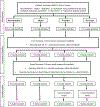Biopsychosocial correlates of discrimination in daily life: A review
- PMID: 32524031
- PMCID: PMC7286570
- DOI: 10.1037/sah0000120
Biopsychosocial correlates of discrimination in daily life: A review
Abstract
The bulk of the literature on the relationship of discrimination to health has relied on retrospective reports of perceived exposure to discrimination. Much less is known known about the real-time within-person association between discrimination and biopsychosocial processes. Intensive longitudinal methods, including ecological momentary assessment (EMA) and daily diary studies, are well suited for studying the dynamic nature of discriminatory experiences in daily life. This review examines research utilizing EMA and daily diaries to study discrimination within individuals in real-time and natural settings. We identified studies of discrimination related to race, sex, weight, and sexual orientation, and examined the prevalence and frequency of discrimination in daily life, the psychosocial correlates of discrimination, contextual factors related to discriminatory experiences, and moderators of the effects of discrimination. We highlight the benefits of using EMA and daily diaries in the study of discrimination and biopsychosocial processes, and provide suggestions for future work on these associations. EMA data suggests that discrimination occurs more frequently than might be clear from survey research and is associated with poor mental health in daily life. Further, discrimination may be enacted through various means (e.g., verbal expressions, behavior), by a variety of perpetrators (e.g., spouses, friends), and in various settings (e.g., in the home, in public places) in daily life. This methodology has potential to facilitate our understanding of the dynamic temporal relationship between cognitive, behavioral, and emotional responses to discrimination and poor health outcomes in daily life.
Keywords: daily diary; discrimination; ecological momentary assessment; health; stigma.
References
-
- Allport GW (1979). The nature of prejudice. Basic books.
-
- Becker JC, & Swim JK (2011). Seeing the unseen: Attention to daily encounters with sexism as way to reduce sexist beliefs. Psychology of Women Quarterly, 35(2), 227–242.
-
- Bolger N, Davis A, & Rafaeli E, (2003). Diary methods: Capturing life as it is lived. Annual Review of Psychology, 54, 579–616. - PubMed
-
- Bradburn NM, Rips LJ, & Shevell SK (1987). Answering autobiographical questions: The impact of memory and inference on surveys. Science, 236(4798), 157–161. - PubMed
-
- Brinkman BG, Garcia K, & Rickard KM (2011). “What I wanted to do was…” Discrepancies between women’s desired and reported responses to gender prejudice. Sex Roles, 65(5–6), 344–355.
Grants and funding
LinkOut - more resources
Full Text Sources
Research Materials

